Bananas React with Many Other Fruits in the Blender, and in Your Stomach.
As you savor the mild tartness of a strawberry, you know you’re benefiting from its exceptionally high Flavan-3-ols content.
Flavan-3-ols are a powerful antioxidant compound, and regular consumption may protect you from a 36.5% risk of stomach cancer, a 24.1% risk of pharyngeal cancer, and an average 6.5% risk of all types of cancers—according to a meta-analysis of evidence from at least 43 epidemiological studies.
Moreover, numerous studies have highlighted a variety of benefits from Flavan-3-ols, ranging from anti-inflammatory properties and improved heart health to beautifying skin and supporting brain health.
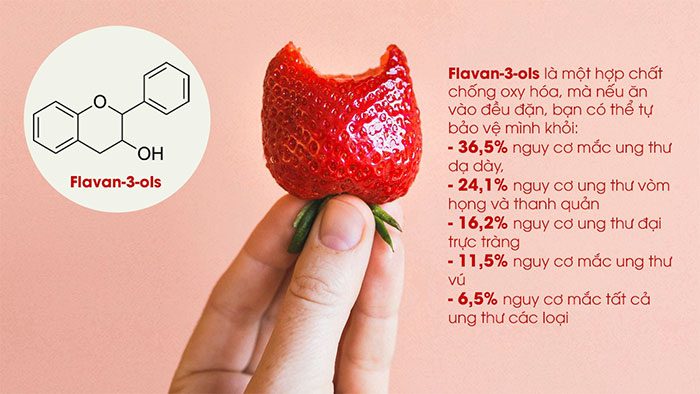
Benefits of Flavan-3-ols in strawberries. (Illustration).
However, to reap the benefits from Flavan-3-ols, there is a challenge you must overcome: the tartness of strawberries. Many people tackle this issue by blending strawberries with bananas to create a smoothie.
The sweetness from the carbohydrates in bananas is considered to be much more natural and healthier than refined sugar. Furthermore, bananas themselves are a healthy fruit, rich in fiber, potassium, and various vitamins and minerals.
Despite this, there is some bad news for fans of the strawberry-banana smoothie.
A study published in the journal Food and Function recently discovered a strange reaction occurring between bananas and strawberries when blended together and in your stomach.
This reaction causes most of the benefits from the Flavan-3-ols in strawberries to disappear when this compound interacts with a substance in bananas, transforming it into something else. And the story doesn’t stop there.

Banana-strawberry is a classic and popular smoothie recipe. (Image: Sweet & Sour Candy).
Scientists recommend that you consider removing bananas from your smoothie recipes, or avoid eating this fruit along with other Flavan-3-ols rich foods like cocoa, apples, pears, grapes, and peaches…
At the very least, this is advisable if you want to maximize the benefits from the antioxidants found in fruits. This also means that even the banana cocoa smoothie—a very delicious and popular recipe—might not be as nutritious as it once seemed.
Bananas React with Strawberries in the Blender
The recent study was conducted by scientists from the University of California, Davis (UCD), who performed a controlled blind experiment on 8 healthy men. These participants were selected and given a strawberry smoothie containing Flavan-3-ols and capsules containing the same amount of Flavan-3-ols.
Subsequent blood tests showed that the concentration of Flavan-3-ols metabolites in the volunteers’ plasma increased accordingly—indicating that this antioxidant compound was absorbed from the strawberry smoothie into the bloodstream and began providing health benefits.
However, on another day, when the volunteers switched to drinking a banana-strawberry smoothie, the concentration of metabolites dropped by as much as 84% compared to when consuming a dose of Flavan-3-ols from the pure capsules.
Dr. Javier Ottaviani, the lead author of the study from the Department of Nutrition at the University of California, stated: “We were truly surprised to see that adding just one banana could quickly reduce the flavanol concentration in the smoothie and in the body.“
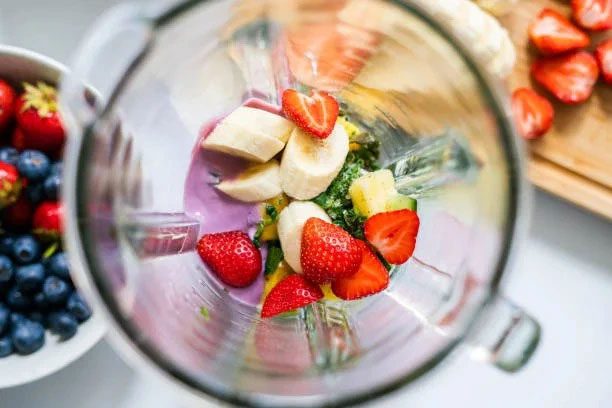
Most of the benefits from Flavan-3-ols in strawberries disappear when this compound interacts with a substance in bananas and is transformed into something else. (Image: Tasting Table).
To understand what was really happening within the mixture, Dr. Ottaviani and colleagues blended a series of pure strawberry smoothies and compared them with the banana-strawberry mixture. The results showed that just one hour later, at room temperature, the concentration of Flavan-3-ols in the banana-strawberry smoothie had significantly decreased compared to pure strawberries.
The reason identified was an enzyme called polyphenol oxidase (PPO) present in bananas. PPO is involved in the oxidation process of bananas and many other fruits. It is the culprit that causes bananas to brown after peeling.
The PPO enzyme also reacts with Flavan-3-ols, causing this compound to become denatured and unable to perform the beneficial reactions for health. Evidence shows that when scientists removed PPO from bananas and blended a mixture with strawberries, the concentration of Flavan-3-ols was no longer diminished.

Illustration.
Do Bananas React with Strawberries in Your Stomach?
Now, with evidence showing that PPO reacts with Flavan-3-ols before consumption, scientists wondered whether a similar reaction occurs in your stomach.
To investigate this, Dr. Ottaviani recruited 11 new volunteers for the next experiment. These volunteers were asked to drink half a cup of strawberry smoothie followed by half a cup of banana smoothie.
This setup prevented bananas and strawberries from reacting before consumption.
Note that the stomach has an acidic pH, and external body tests have shown that acidic pH can somewhat inhibit the reaction between PPO and Flavan-3-ols. If so, the hypothesis arises that you could eat the fruits sequentially, and the benefits of Flavan-3-ols would be preserved as this mixture enters the acidic environment of the stomach?

Illustration.
Unfortunately, the results of the experiment did not support the above hypothesis. In fact, scientists found that the reaction between bananas and strawberries occurred even more vigorously when entering the human stomach.
After testing the blood of volunteers who consumed the two smoothies sequentially, they found no presence of any Flavan-3-ols metabolites. It seems this antioxidant was completely neutralized by the PPO in bananas.
“Previous studies conducted on humans have shown that the acidity in the stomach changes very quickly after eating, rising from pH 2 to pH 5, and takes over an hour to return to pH 2. Meanwhile, the pH range of 4 to 5 is very conducive to the reaction of PPO present in bananas“, the scientists wrote.
Additionally, the protein breakdown reaction in the stomach may also release additional latent PPO present in bananas. This increases the concentration of PPO during the early stages of digestion, leading to a stronger reaction with Flavan-3-ols.
In summary, the environment in the stomach even more thoroughly neutralizes the health benefits of strawberries due to the bananas.
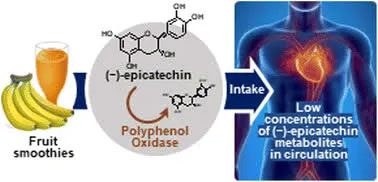
The stomach environment even more thoroughly neutralizes the health benefits of strawberries due to bananas.
And It’s Not Just Bananas and Strawberries
Professor of Nutrition and Food Science Gunter Kuhnle, one of the co-authors of the study from the University of Reading, stated:
“There have been previous studies showing that flavanols can be degraded by PPO. However, we are still very surprised by the extent of the impact of just one banana. It has enough PPO to neutralize most of the flavanols in strawberries.“
“Bananas themselves are a wonderful fruit and can play an important role in a healthy diet, but if you want to increase your flavanol intake, you may need to leave them out of your morning smoothie,” Professor Kuhnle added.
Additionally, since the primary reaction discovered here is between PPO and flavanols, researchers also recommend a long list of other flavanol-rich fruits that you should avoid combining with bananas.
These include all types of berries such as blueberries, raspberries, grapes, along with apples, peaches, and pears. Tea and cocoa products like chocolate also contain high levels of Flavan-3-ols, so the benefits from this compound will be diminished if consumed with bananas.

Even the banana cocoa dish—a very delicious and popular recipe—might not be as nutritious as it once seemed.
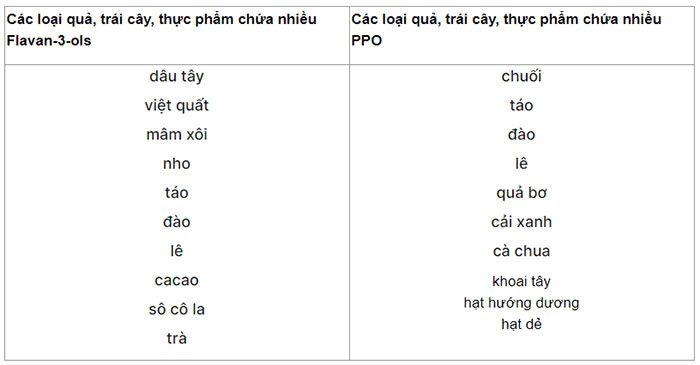
Conversely, apples, peaches, and pears also contain significant amounts of PPO, making them foods you should not combine with strawberries and other Flavan-3-ols rich foods. Kale and tomatoes are also on this list. Identifying foods that contain PPO is quite easy; they tend to change color and brown after being cut.
Foods with low levels of polyphenol oxidase (PPO) are less likely to change color after peeling, such as oranges or pineapples. Yogurt is also one of the ingredients that makes smoothies delicious while containing low PPO levels, making it a good substitute for bananas to add sweetness.
This means that next time you visit a café and intend to order a banana cocoa smoothie, consider swapping it for a yogurt cocoa to maximize health benefits. A strawberry banana smoothie can also be replaced with strawberry yogurt if you need a bit of sweetness.
“For consumers looking to increase their flavanol intake through fruit smoothies, it is best to avoid combining flavanol-rich foods, such as strawberries, with fruits and vegetables high in polyphenol oxidase, like bananas,” Dr. Ottaviani emphasized.
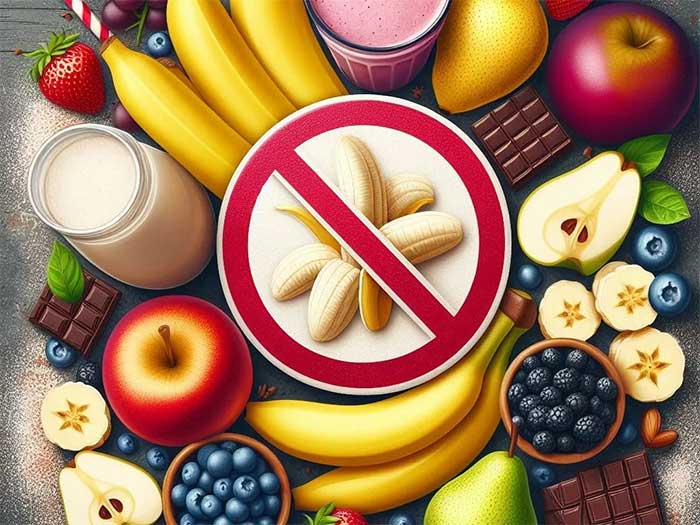
Bananas do not pair well with multiple types of fruit at once.
He mentioned that his research serves not only as a useful reference for juice or smoothie makers but can also apply to the nutritional beverage industry, including companies producing fruit juices or ready-to-drink smoothies.
“To fully harness the health-supporting potential of these products, we need to study how to process, preserve, and consume them as part of an overall meal combination,” the researchers wrote.
The peculiar interaction between bananas and strawberries is just a small example among countless interactions between food items, as well as the compounds within them, that nutritional science continues to explore.


















































